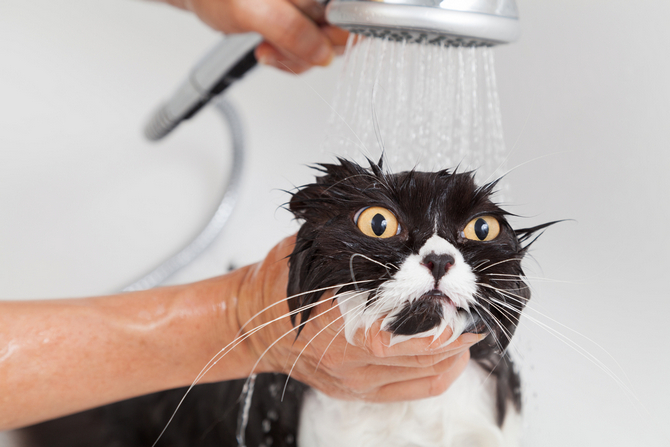For some cat owners, a constant concern is finding fleas and ticks on their cats. Whether you decide to keep your pets indoors or keep them in the yard, it is necessary to worry about ticks and fleas on your beloved cat and be balanced on the subject. Why balanced? Many people do not give the proper importance to these little pests being on their pets. The reason is that they keep their pets out of the house, not keeping in mind that cats also suffer and get sick when they have ticks or fleas.
On the other hand, others may refuse the happiness and tenderness of a kitten in the home to prevent the proliferation of ticks or fleas. Which is a valid point, but it has a solution: Avoiding the proliferation of fleas and ticks on your cat in the first place. That way you, your family and your cat will be healthy and happy. To help you achieve this goal, here are seven tips for you to prevent ticks and fleas on your cat.

Tips to Prevent Ticks and Fleas
1. Eliminate ticks and fleas right away.
In the first place, if you already detected ticks or fleas in your cat, eliminate them immediately. Both in the fur of your cat and in your home, to prevent fleas or ticks from ever biting your cat again.
2. Products you can apply on your cat.
We know that cats are elegant animals that need to always groom themselves. So, products designed to place on the cat's skin, are often placed on the back of the cat's neck. Wherein a part where they cannot access (and you’d rather avoid touching after you put it on). These are liquids that your cat’s skin absorbs and then fights the fleas and ticks. An example of this is Frontline Combo Spot On that kills fleas and ticks and protects your cat for four weeks. Despite this, some of these products kill fleas and ticks, but do not offer future protection from these parasites, so you must choose well. There are also powders and sprays designed to prevent fleas and ticks from biting your cat, these are also a good option.
3. Products you can feed your cat with.
Like Program, an oral suspension flea treatment for cats. You can put this product in your cat's food for them to ingest it. Its effect lasts one month and it is designed to prevent the multiplication of flea eggs on your cat.
4. Put a fleas collar on your cat.
Fleas collars can do the job to prevent fleas from ever biting your cat; you have to change it every three months in order to offer better protection. Seresto is a popular brand that also affects the flea’s larvae. This is a product that offers the longest protection against fleas so far in the market. This particular brand protects your cat for eight months straight.
5. Bathing your cat with soap or shampoo
 Although cats do not need as many baths as dogs, since they devote themselves to their own grooming. Experts consider that bathing them too often is not good, because it removes all the natural oils that protect their skin. Yet, a bath is not harmful at all to the kitty. To dilute and add a little bit of the shampoo for ticks and fleas to your cat’s usual bath will help to keep it clean, healthy and prevent ticks and fleas from getting on your cat.
Although cats do not need as many baths as dogs, since they devote themselves to their own grooming. Experts consider that bathing them too often is not good, because it removes all the natural oils that protect their skin. Yet, a bath is not harmful at all to the kitty. To dilute and add a little bit of the shampoo for ticks and fleas to your cat’s usual bath will help to keep it clean, healthy and prevent ticks and fleas from getting on your cat.
6. Constantly checking the cat's fur.
This will help you keep it clean. Especially if the cat is used to being outside the house, as it could catch fleas and ticks from other cats or dogs even. There are brushes specially designed to comb the fur of the cat and help discover any hidden pests within its dense fur. It is especially helpful to take into account the weather. Usually, when the warmer months of the year are approaching, it is more likely to find fleas or ticks lodged on your cat.
7. Cleaning and decluttering your house.
Keeping your home clean and limiting the cat’s access to the outdoors can diminish the probabilities of these small parasites biting your cat. Another factor could come from other pets you might have at home, so be sure all your pets are free from ticks and fleas. If the tick and flea problem is too frequent and you happen to have a garden in your house; carry out a fumigation and maintain the grass of the garden low to avoid the proliferation of these invaders.

Bottom Line
Before putting into practice any kind of treatment for the cat, it is advisable to visit the veterinarian. The veterinarian is the better-qualified person to indicate the best way to kill ticks and fleas on your pet. Especially if the cat is very old or a kitten or even if it already has some kind of disease.
Furthermore, don't forget to take into account how the treatment may affect the cat. For this reason, after applying any treatment, observe your cat with attention on the following days. If the skin starts to turn red, your cat starts to vomit, lose appetite, has excessive anxiety or shows any other anomalies, suspend the treatment straight away and consult a veterinarian. Likewise, it is absolutely necessary that the treatment you give to your cat is actually made for cats and not for dogs, as that can be harmful to the cat. To decide the best treatment for your cat remember to take into account your cat’s lifestyle and the environment in which it lives. Pet Comments does not encourage or favor any particular medication. We truly hope this article has been helpful to you!
References:
- WebMD, Protect Your Cat and Home From Fleas
- Pet Health Network, Protecting Your Cat from Fleas and Ticks